Judethaddeusmoseti
On this page, you find all documents, package deals, and flashcards offered by seller judethaddeusmoseti.
- 39
- 0
- 2
Community
- Followers
- Following
41 items
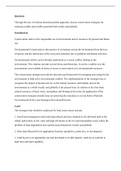
JOUR458- Environment conservation strategies for reducing conflict and conflict potential both locally and globally.
Question: Through the lens of solution based journalism approach, discuss conservation strategies for reducing conflict and conflict potential both locally and globally. Introduction Conservation refers to the responsible use of environment and its resources for present and future use. Environmental Conservation is the practice of us humans saving the environment from the loss of species and the destruction of the ecosystem primarily due to pollution and human activities. Environmental co...
- Summary
- • 17 pages •
Question: Through the lens of solution based journalism approach, discuss conservation strategies for reducing conflict and conflict potential both locally and globally. Introduction Conservation refers to the responsible use of environment and its resources for present and future use. Environmental Conservation is the practice of us humans saving the environment from the loss of species and the destruction of the ecosystem primarily due to pollution and human activities. Environmental co...
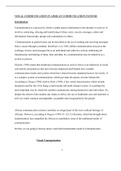
COMM382- African communication systems
African communication systems constitute an integral part of the socio-cultural heritage of Africans. However, according to Ibagere (1994:81- 82), Civilization, which has brought about modernization, has compelled the African to cannibalize some of the traditional modes of communication. On this, we are going to discuss about visual and instrumentals mode of communication.
- Summary
- • 16 pages •
African communication systems constitute an integral part of the socio-cultural heritage of Africans. However, according to Ibagere (1994:81- 82), Civilization, which has brought about modernization, has compelled the African to cannibalize some of the traditional modes of communication. On this, we are going to discuss about visual and instrumentals mode of communication.
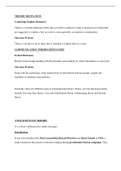
JOUR200 - KEY COMMUNICATION THEORIES
COMMUNICATION THEORY DEFINATION Oxford Dictionary Branch of knowledge dealing with the principles and methods by which information is conveyed. Merriam-Webster Deals with the technology of the transmission of information between people, people and machines or machines and machines. Generally, there are different types of communication theory. Below, are four discussed which include Two-step flow theory, Uses and Gratification theory, Gatekeeping theory and System theory.
- Summary
- • 29 pages •
COMMUNICATION THEORY DEFINATION Oxford Dictionary Branch of knowledge dealing with the principles and methods by which information is conveyed. Merriam-Webster Deals with the technology of the transmission of information between people, people and machines or machines and machines. Generally, there are different types of communication theory. Below, are four discussed which include Two-step flow theory, Uses and Gratification theory, Gatekeeping theory and System theory.
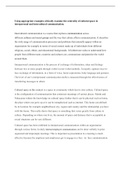
COMM382 - CENTRALITY OF INTERPERSONAL SPACE INTERCULTURAL COMMUNICATION
Intercultural communication is a course that explores communication across different cultures and social groups and the way that culture affects communication. It describes the wide range of communication processes and problems that naturally appear within an organization for example in terms of social context made up of individuals from different religious, social, ethnic, and educational backgrounds. It furthermore seeks to understand how people from different state, countries and cultures act...
- Book
- Presentation
- • 5 pages •
Intercultural communication is a course that explores communication across different cultures and social groups and the way that culture affects communication. It describes the wide range of communication processes and problems that naturally appear within an organization for example in terms of social context made up of individuals from different religious, social, ethnic, and educational backgrounds. It furthermore seeks to understand how people from different state, countries and cultures act...
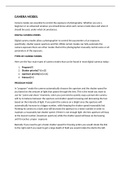
CAMERA MODES
CAMERA MODES. Camera modes are essential to control the exposure of photography. Whether you are a beginner or an advanced amateur you should know what each camera mode does and when it should be used, under what circumstances.
- Summary
- • 2 pages •
CAMERA MODES. Camera modes are essential to control the exposure of photography. Whether you are a beginner or an advanced amateur you should know what each camera mode does and when it should be used, under what circumstances.
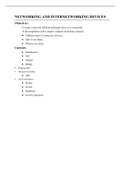
NETWORKING AND INTERNET WORKING DEVICES
Objectives: To make a network, different topologies have to be connected. At the completion of this chapter, students should have learned: • Different types of connective devices; • How to use them; • When to use them; Contents: • Introduction • NIC • Modem • Bridge • Bridging table • Message forwarding • Hub • Active and passive • Router • Switch • Backbone
- Summary
- • 12 pages •
Objectives: To make a network, different topologies have to be connected. At the completion of this chapter, students should have learned: • Different types of connective devices; • How to use them; • When to use them; Contents: • Introduction • NIC • Modem • Bridge • Bridging table • Message forwarding • Hub • Active and passive • Router • Switch • Backbone

PHOTOGRAPHIC LIGHTING.
PHOTOGRAPHIC LIGHTING. Photographic lighting is the illumination of scenes to be photographed. A photograph simply records patterns of light, color, and shade; lighting is all important in controlling image .illumination is desired to give an accurate rendition of the scene in other cases the direction, brightness, and color of light are manipulated for effect .lighting is particularly important for monochrome photography, where there is no color information, only the interplay of highlights an...
- Summary
- • 4 pages •
PHOTOGRAPHIC LIGHTING. Photographic lighting is the illumination of scenes to be photographed. A photograph simply records patterns of light, color, and shade; lighting is all important in controlling image .illumination is desired to give an accurate rendition of the scene in other cases the direction, brightness, and color of light are manipulated for effect .lighting is particularly important for monochrome photography, where there is no color information, only the interplay of highlights an...
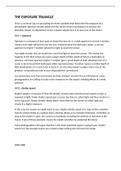
THE EXPOSURE TRIANGLE
THE EXPOSURE TRIANGLE This is a common way of associating the three variables that determine the exposure of a photograph: Aperture shutter speed and ISO. All the three must balance to achieve the desirable results; an adjustment of one requires adjustment of at least one of the others.
- Summary
- • 2 pages •
THE EXPOSURE TRIANGLE This is a common way of associating the three variables that determine the exposure of a photograph: Aperture shutter speed and ISO. All the three must balance to achieve the desirable results; an adjustment of one requires adjustment of at least one of the others.
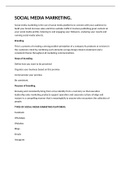
SOCIAL MEDIA MARKETING.
Social media marketing is the use of social media platforms to connect with your audience to build your brand increase sales and drive website involves publishing great content on your social media profile, listening to and engaging your followers, analyzing your results and running social media adverts.
- Essay
- • 4 pages •
Social media marketing is the use of social media platforms to connect with your audience to build your brand increase sales and drive website involves publishing great content on your social media profile, listening to and engaging your followers, analyzing your results and running social media adverts.

END'S BEGINNING Revised shooting script
END'S BEGINNING Revised shooting script Has the strictly rules governed film trends.
- Essay
- • 11 pages •
END'S BEGINNING Revised shooting script Has the strictly rules governed film trends.
